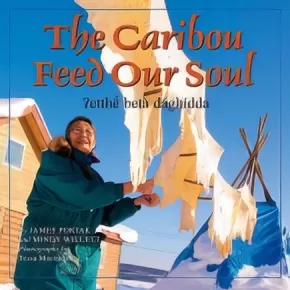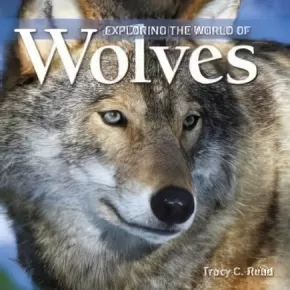Text Features
- Nonfiction text features help to make the important information easier to find.
- Nonfiction text features usually highlight the most important pieces of information.
Some Common Nonfiction Text features:
labels, bold words, titles, headings, charts, table of contents, fact boxes, photographs, index, captions, italics, diagrams, maps, glossary, illustrations, graphs, webs, speech bubbles.
Synopsis:
Pete Enzoe is Chipewyan Dene from Lutsel K’e, Northwest Territories, on the East Arm of Great Slave Lake. He is a hunter, fisher, and trapper. He sees his role in life as protector of the caribou and spends much of his time “reading” the land as he travels his peoples’ traditional areas. Pete also helps scientists to monitor the herd’s health and migration. In The Caribou Feed Our Soul, the sixth book in The Land is Our Storybook series, Pete takes readers on a respectful caribou harvest. Along the way, he shares creation stories about how his people are descendants of the caribou. He also describes the spiritual areas his community is trying to protect, including Thaidene Nene, which means “land of our ancestors.” Pete’s stories help the reader to understand the rich history of the Chipewyan Dene and their relationship with the caribou today.
Educator & Series Information
This is the sixth book in the "The Land Is Our Storybook" series, which considers the diverse lands and cultures of Canada's Northwest Territories. Told in a uniquely diverse range of northern voices, with a child-centred approach, books in the series highlight each official Aboriginal language group in the NWT, revealing a richly textured picture of life in the North-on the trapline, around the campfire, in communities, at school, and within the outdoor school that is the land itself. The series celebrates the seasons, ages, genders, traditional activities, and communities of the NWT.
The stories are illustrated by the striking images of acclaimed northern photographer, Tessa Macintosh and depict the similarities in lifestyle between children of the North and South, as well as the marked cultural differences, and highlight the special relationship these First Nations people have with the land and how they are adapting to rapid change while remaining connected to the land. Images of the landscape and animals within it, of trapping, hunting, fishing, and bannock baking sit alongside pictures of children at school, swimming at recreation centres, and reading in libraries. Here is modern northern culture painted beautifully: a complex mix of the new and the old.
These wonderful books, written with a variety of provincial and territorial curricula in mind, are specially designed for the classroom and include special features such as glossaries relating details on animals biology and cultural definitions, regional and language maps. The text of the stories also have sidebars such as Our Stories, which contain the stories of the people and language group featured, and Our Words, which highlight words in the featured language that are important to the story.
Recommended Grade Level: 2-7
Additional Information
|
Synopsis:
Coyotes are wily, secretive and extremely adaptive -- what young reader wouldn't be fascinated?
Familiar to kids and adults alike through its many appearances in folk and popular culture, the multicolored coyote has the gray wolf to thank for its survival. As humans eliminated wolf populations across the continent over the last century, the coyote easily filled the gap. Today it is the most successful and most numerous large predator in North America. It makes its homes not only in the wild but increasingly in suburbs and even urban centers -- the coyote is wary of humans but is quite willing to enter the human world in pursuit of food.
The coyote has a curious blend of characteristics that it shares with its dog-family relatives, the wolf and the red fox. Like the red fox, it has graceful, catlike movements. Like the wolf, it can hunt in packs but may also hunt on its own or with a partner.
Exploring the World of Coyotes explains how the wily coyote achieved such great success, from its elaborate communication skills, mate selection and family life to its adaptive life skills and physical characteristics.
Educator & Series Information
This book is part of the "Exploring the World of..." series, a nature series produced especially for young readers who are eager to learn more about the wild animals they find especially appealing. The books are packed with facts and offer outstanding value. Clear text in large type and vivid photographs with explanatory captions describe the animals' physical attributes, and storylike narratives about their daily life -- where they live, what they eat, how they hunt, how they communicate, how they raise their young -- present a complete picture of each animal.
Additional Information
24 pages | 8.00" x 8.00"
Synopsis:
High flight with North America''s mighty eagles.
Only two kinds of eagles live in North America, the bald eagle and the golden eagle. These majestic birds belong to the same family and share many physical traits and behaviors, but there are also important differences between them.
In this fully illustrated introduction, young readers will discover why the bald eagle lives along the coastlines of oceans, lakes and rivers while the golden eagle prefers mountainous regions, prairies and plains. They''ll learn about the impressive nest-building skills of these two raptors and their courtship displays, mating patterns and fierce hunting styles.
Full-color photographs provide close-ups and action shots of these aerial performers, while the engaging text, sidebars and captions offer insights into the life history of two of the world''s most powerful winged predators.
Series Information
This book is part of the "Exploring the World of..." series, a nature series produced especially for young readers who are eager to learn more about the wild animals they find especially appealing. The books are packed with facts and offer outstanding value. Clear text in large type and vivid photographs with explanatory captions describe the animals' physical attributes, and storylike narratives about their daily life -- where they live, what they eat, how they hunt, how they communicate, how they raise their young -- present a complete picture of each animal.
Additional Information
24 pages | 8.00" x 8.00"
Synopsis:
The wild, wary gray wolf.
The largest wild member of the dog family, the gray wolf stalks much larger mammals, such as the elk, caribou and moose. How does it succeed? Built to run, the long-legged wolf on the hunt uses its powerful sight, hearing, smell and physical strength. But, like the domestic dog, the wolf is a social animal: it lives in a pack.
In this fully illustrated introduction, young readers will learn how group living makes sense for the wolf, allowing it to form strong bonds and share tasks like rearing its young, finding food and communicating over long distances. They''ll also find out how habitat destruction, poisoning campaigns and hunting have reduced gray wolf populations in much of North America.
Full-color photographs provide close-ups and action shots, while the engaging text, sidebars and captions tell the life history of an animal that researchers agree has one of nature''s most engaging personalities.
Educator & Series Information
This book is part of the "Exploring the World of..." series, a nature series produced especially for young readers who are eager to learn more about the wild animals they find especially appealing. The books are packed with facts and offer outstanding value. Clear text in large type and vivid photographs with explanatory captions describe the animals' physical attributes, and storylike narratives about their daily life -- where they live, what they eat, how they hunt, how they communicate, how they raise their young -- present a complete picture of each animal.
Additional Information
24 pages | 8.00" x 8.00"
Synopsis:
Dazzling inventions from the far north.
Today's Arctic communities have all the comforts of modern living. Yet the Inuit survived in this harsh landscape for hundreds of years with nothing but the land and their own ingenuity. Join authors Alootook Ipellie and David MacDonald as they explore the amazing innovations of traditional Inuit and how their ideas continue to echo around the world.
Some inventions are still familiar to us: the one-person watercraft known as a kayak retains its Inuit name. Other innovations have been replaced by modern technology: slitted snow goggles protected Inuit eyes long before sunglasses arrived on the scene. And other ideas were surprisingly inspired: using human-shaped stone stacks (lnunnguat) to trick and trap caribou.
Many more Inuit innovations are explored here, including:
- Dog sleds
- Kids' stuff
- Shelter
- Food preservation
- Clothing
- Medicine.
In all, more than 40 Inuit items and ideas are showcased through dramatic photos and captivating language. From how these objects were made, to their impact on contemporary culture, The Inuit Thought of It is a remarkable catalog of Inuit invention.
Educator & Series Information
Recommended Ages: 10-12.
B.C. Science Supplementary Resource: Gr.3- Physical Science
B.C. Science Supplementary Resource Gr.4- Life Science
This book is a part of the We Thought of It series, a series which takes readers on a fascinating journey across the world's second largest continent to discover how aspects of its culture have spread around the globe.
Additional Information
32 pages | 8.50" x 11.00"











